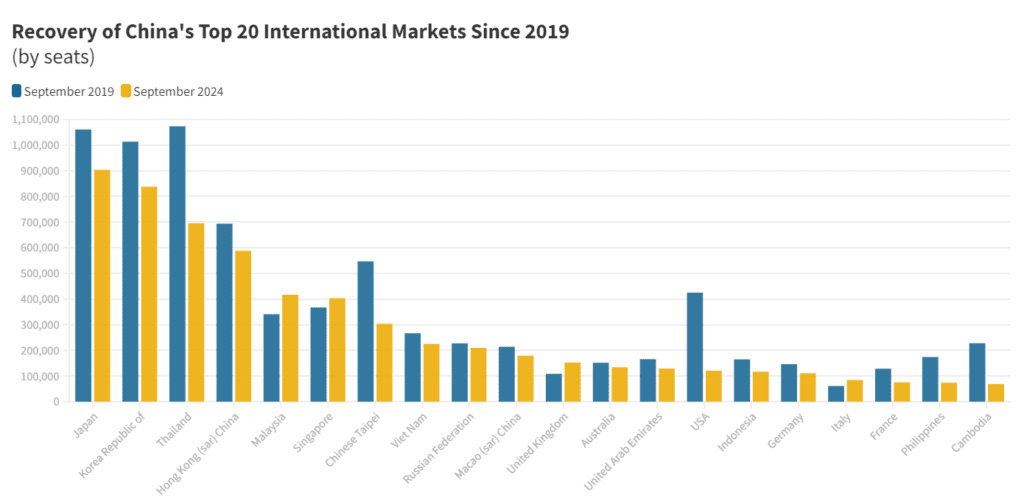
[ad_1]
Skift Take
While China’s visa exemptions simplify travel, they alone cannot bring back 2019’s robust visitor numbers. Without a full recovery of flight capacity, particularly in top markets, the tourism boost China is hoping for may remain out of reach.
Peden Doma Bhutia
Norwegian citizens will no longer need a visa to enter China for visits up to 15 days. The policy shift sees China place Norway in a select group of nations as part of a wider relaxation of visa rules for inbound visitors.
Prime Minister Jonas Gahr Store, currently visiting China, emphasized the benefits of this policy. “This will make travelling to China much easier for Norwegian business representatives, students, and others. It also lays the foundation for more cooperation,” Store said during a press briefing following his meeting with Chinese President Xi Jinping.
Norway is currently the only Scandinavian country on China’s visa-free list. It joins a growing list of nations, including European countries like Ireland, Germany, and Spain whose citizens are able to take advantage of the waiver.
Norway and China Relations
With China and Norway commemorating the 70th anniversary of diplomatic relations this year, the timing of this announcement is also symbolic.
In November 2023, China included Norway as the 54th country in its 72/144-hour transit visa-free policy.
The program now covers 37 ports and applies to citizens from 54 countries, including the U.S., Canada, and the United Kingdom. Foreign nationals holding a valid passport from these countries can enjoy a 72/144-hour stay in the 23 Chinese cities without a visa, provided they hold a connecting ticket with the confirmed departure date for a third country or region.
China is particularly keen to attract Norwegian travelers to destinations beyond Beijing and Shanghai. For example, the Chengdu Municipal Bureau hosted a tourism promotion event in Oslo last week.
Despite this step forward, there’s a notable absence of reciprocity. While Norwegians can now travel to China visa-free, Norway still requires Chinese citizens to apply for a visa.
This stems from Norway’s membership in the Schengen area, which mandates a shared visa policy among its members. As the Norwegian ministry of justice explained to the Norwegian Broadcasting Corporation (NRK), “Like other Schengen member countries, we cannot offer a similar arrangement in return.”
China’s Broader Push for Visa-Free Travel
This policy extension to Norway follows a broader trend in China’s visa policy evolution. Over the past year, China has extended visa-free entry to citizens from several countries, including France and Malaysia, as part of a trial program.
China initially announced the policy for a trial period until November 30 this year, but is now set to run through 2025.
The scheme is credited as a key factor in boosting China’s inbound tourism, with over 17.25 million foreign tourists visiting between January and July 2024, marking a 130% year-on-year increase.
Visa-exempt entries have fueled the surge in foreign arrivals, highlighting China’s ambition to revitalize its tourism sector after the pandemic.
China recorded over 8.5 million visa-free entries between January and June this year, accounting for 58% of inbound travel, a 190% increase over last year.
Flight Capacity Lags Behind
Despite the positive momentum, China’s inbound travel numbers have yet to reach pre-pandemic levels. In 2019, China welcomed over 49 million foreign visitors, a figure that remains distant despite this year’s rebound.
China’s aggressive expansion of visa-free policies is part of its broader strategy to boost inbound tourism, but a critical factor still hampers its recovery: flight capacity. While more countries gain visa-free access, international air travel to China remains well below pre-pandemic levels.
Japan, which is currently the busiest market for flights to China, operates 903,000 seats this month — down from a little less than 1.1 million in September 2019, according to flight data from OAG. South Korea, another key market, follows a similar trend with 838,000 seats, also falling short of its pre-pandemic figures. Thailand, despite being a popular destination, has seen its capacity drop by 35% compared to 2019, and even more starkly, by 16% just from last month.


India’s case is perhaps the most striking. In December 2019, 539 direct flights connected India and China each month. Today, there are none.
[ad_2]